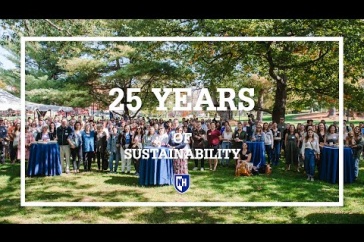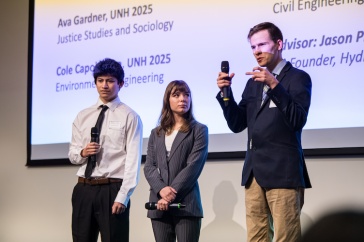Ask Cameron Wake to describe UNH’s response to reducing greenhouse gas emissions (GHGE) and one word comes to mind: aggressive.
WildCAP, the university’s climate action plan, is “considerably more aggressive” than emissions reduction goals for both New England and the United States. Though President Donald Trump announced earlier this year that the U.S. will withdraw from the Paris climate accord, UNH continues to work toward reducing emissions and adapting to a changing climate.
A Bright Idea?
Rising above Main Street, Holloway Commons is one of the Durham campus’ most prominent landmarks — and the inspiration for one of sustainability-minded students’ most frequently asked questions: If the university is so sustainable, why doesn’t it put solar panels on HoCo’s southerly facing roof?

The simple answer is that solar power is a less efficient source of renewable energy for the campus than the one currently in place: the cogeneration plant. Not only would a solar system be limited to providing only electricity, the peak months for generating solar power occur in summer — when most students are home and the campus’ electricity needs are the lowest. The landfill gas-powered cogen plant, by contrast, generates both electric power and heat, and the steam that warms dorms and classrooms in winter is used to run campus air conditioning systems in the summer. So why not have both? Matt O’Keefe, UNH’s director of energy and utilities, explains that adding a solar energy source on top of the cogen plant would effectively decrease the energy output from the plant during peak solar hours — which ultimately makes the system less effective overall. That’s not to say that solar won’t be a factor in future building projects. “Our existing system is optimized for the current campus, but future large buildings will very likely create additional year-round energy demands,” O’Keefe says. “I think it’s safe to say five to 10 years from now you’ll see solar arrays incorporated into building plans.”
Wake, a climate change researcher and a member of the UNH Energy Task Force, says the GHGE reduction goals set out in WildCAP set UNH apart from other institutions. The plan? A 50 percent reduction in 2001 GHGE levels by 2020, an 80 percent reduction by 2050, and a path to carbon neutrality by 2100. It’s a tougher standard than that set by the Paris accord, which called for a 26 to 28 percent decrease in 2005 GHGE levels by 2025.
UNH is not only setting lofty goals, it is meeting them. In FY17, the university achieved 51 percent GHGE reductions — meeting the 2020 goal three years early. Now, the energy task force is looking ahead to the next challenge: getting to 80 percent reduction by 2050.
That will continue to require a systematic, ground-up approach, from energy-use challenges in the dorms and reducing the number air travel miles faculty and staff use to UNH’s cogeneration power plant and the revolutionary EcoLine project, which converts gas from a landfill in Rochester into energy for campus. Under a new contract, energy that is imported to campus is now coming from small hydroelectric power suppliers in New Hampshire. Article These initiatives reduce GHGE — and bring down energy costs. The effects ripple outward.
“It’s not just about greenhouse gas emissions, it’s not just about water, it’s not just about flooding or food, it’s about all those things and more. It’s about ecosystems and social and environmental justice as well,” Wake says.
This fall, the Sustainability Institute will launch a new tool for managing campus carbon and nitrogen footprints. The new Sustainability Indicator Management and Analysis Platform (SIMAP) is another example of how a deep commitment to sustainability across operations, curriculum, research and engagement makes a broad impact throughout the world. It is based on one of UNH’s “big success stories,” Wake says, a carbon calculator tool developed here in 2001 and already used by thousands of universities and colleges.
“We’ve found we can solve the problem and save money, that reducing our emissions is really good for our bottom line,” Wake says. “There’s an environmental ethic here that’s combined with good old Yankee frugalness, this idea that we shouldn’t be wasting things.”?

?
?
Read?more about the overarching story of?sustainability at UNH here:
-
Blue and White and Green All Over
-
Farm to Future
-
New Angles on Old Problems
-
Starting Somewhere
-
People Power
?
?
Originally published in?UNH Magazine Fall 2017?Issue
?
-
Written By:
Larry Clow '12G | UNH Cooperative Extension




















































